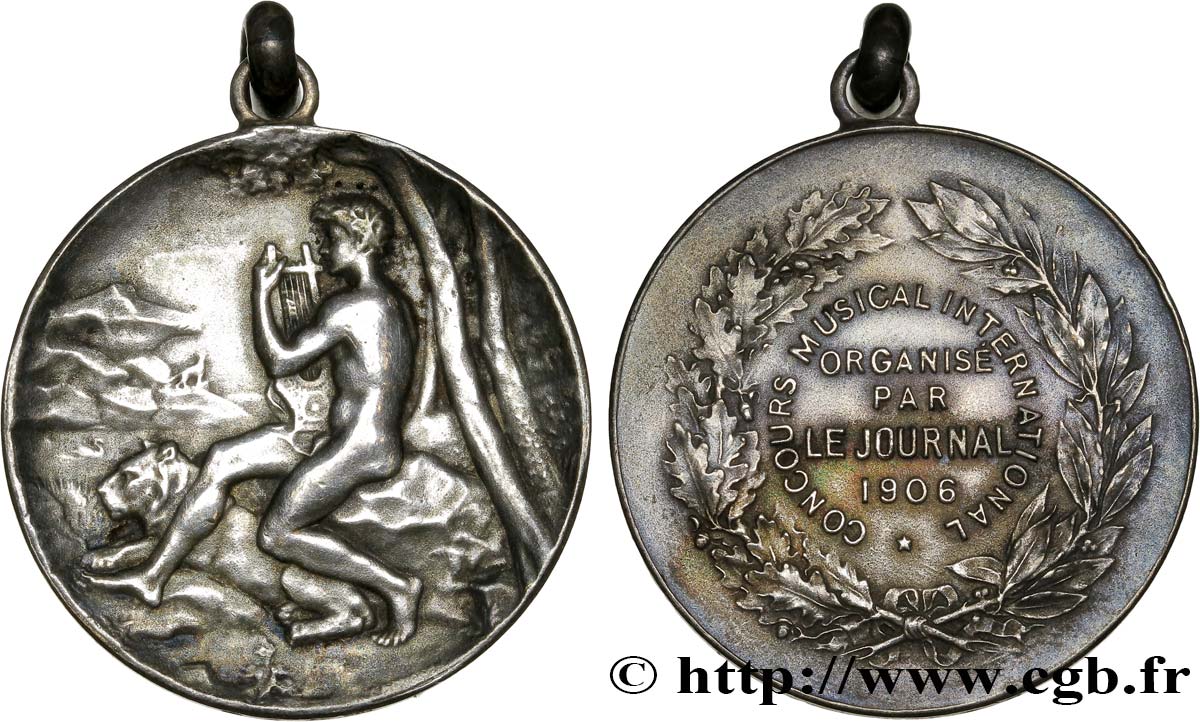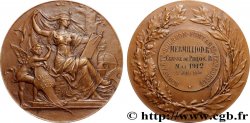fme_370753 - TERZA REPUBBLICA FRANCESE Médaille du concours musical
non disponibile.
Articolo venduto sul nostro negozio (2017)
Prezzo : 100.00 €
Articolo venduto sul nostro negozio (2017)
Prezzo : 100.00 €
Tipo : Médaille du concours musical
Data: 1906
Nome della officina / città: France
Metallo : argento
Diametro : 30 mm
Asse di coniazione : 12 h.
Incisore MOUCHON Louis-Eugène (1843-1914)
Peso : 12 g.
Orlo : lisse + losange ARGENT
Commenti sullo stato di conservazione:
Jolie médaille avec sa bélière. Patine grise
Diritto
Titolatura diritto : ANÉPIGRAPHE.
Descrittivo diritto : Jeune homme nu assis sur un rocher jouant de la lyre ; un tigre à ses pied et un paysage lacustre en arrière plan.
Rovescio
Titolatura rovescio : CONCOURS MUSICAL INTERNATIONAL // ORGANISÉ / PAR / LE JOURNAL / 1906.
Descrittivo rovescio : Légende circulaire et en quatre lignes horizontales dans une couronne de chêne et de lauriers.
Commento
Signature à peine lisible en bord de flan au droit.
Louis-Eugène Mouchon, né à Paris le 30 août 1843 et mort à Montrouge le 3 mars 1914, est un graveur de timbres-poste et graveur-médailleur français, notamment de la série d'usage courant de France qui porte son nom, le type Mouchon.
En 1903, d'après une plaque en relief fournie par Oscar Roty représentant la Semeuse de la monnaie, il grave la Semeuse.
On lui connaît également des gravures pour des billets de banque serbes (10 dinars 1887).
Ce concours pourrait être celui de Lourdes, avec la Lyre Montagnarde de Lourdes, organisé les 3 et 4 juin 1906, ou bien celui de Paris, organisé aux mêmes dates par “Le Journal”.
Le Journal était un quotidien français qui parut entre 1892 et 1944 dont le siège se trouvait au 100 rue de Richelieu dans le 2e arrondissement de Paris. Dans ses premières années (jusqu'en 1911), c'est un journal littéraire de tendance républicaine. C'est l'un des quatre plus grands quotidiens français d’avant-guerre, avec Le Petit Parisien, Le Matin, et Le Petit Journal. Son orientation nationaliste se renforce ensuite au fil des années, amenant à sa disparition avec la fin du régime de Vichy en 1944..
Barely legible signature on the edge of the right side.
Louis-Eugène Mouchon, born in Paris on August 30, 1843 and died in Montrouge on March 3, 1914, was a French postage stamp engraver and medal engraver, notably of the common use series of France which bears his name, the Mouchon type.
In 1903, based on a relief plate provided by Oscar Roty representing the Sower of coin, he engraved the Sower.
He is also known to have engraved Serbian banknotes (10 dinars 1887)..
This competition could be that of Lourdes, with the Lyre Montagnarde de Lourdes, organized on June 3 and 4, 1906, or that of Paris, organized on the same dates by “Le Journal”.
Le Journal was a French daily newspaper that appeared between 1892 and 1944, with its headquarters at 100 rue de Richelieu in the 2nd arrondissement of Paris.. In its early years (until 1911), it was a literary journal with a republican tendency.. It is one of the four largest pre-war French daily newspapers, along with Le Petit Parisien, Le Matin, and Le Petit Journal.. Its nationalist orientation then strengthened over the years, leading to its disappearance with the end of the Vichy regime in 1944..
Louis-Eugène Mouchon, né à Paris le 30 août 1843 et mort à Montrouge le 3 mars 1914, est un graveur de timbres-poste et graveur-médailleur français, notamment de la série d'usage courant de France qui porte son nom, le type Mouchon.
En 1903, d'après une plaque en relief fournie par Oscar Roty représentant la Semeuse de la monnaie, il grave la Semeuse.
On lui connaît également des gravures pour des billets de banque serbes (10 dinars 1887).
Ce concours pourrait être celui de Lourdes, avec la Lyre Montagnarde de Lourdes, organisé les 3 et 4 juin 1906, ou bien celui de Paris, organisé aux mêmes dates par “Le Journal”.
Le Journal était un quotidien français qui parut entre 1892 et 1944 dont le siège se trouvait au 100 rue de Richelieu dans le 2e arrondissement de Paris. Dans ses premières années (jusqu'en 1911), c'est un journal littéraire de tendance républicaine. C'est l'un des quatre plus grands quotidiens français d’avant-guerre, avec Le Petit Parisien, Le Matin, et Le Petit Journal. Son orientation nationaliste se renforce ensuite au fil des années, amenant à sa disparition avec la fin du régime de Vichy en 1944..
Barely legible signature on the edge of the right side.
Louis-Eugène Mouchon, born in Paris on August 30, 1843 and died in Montrouge on March 3, 1914, was a French postage stamp engraver and medal engraver, notably of the common use series of France which bears his name, the Mouchon type.
In 1903, based on a relief plate provided by Oscar Roty representing the Sower of coin, he engraved the Sower.
He is also known to have engraved Serbian banknotes (10 dinars 1887)..
This competition could be that of Lourdes, with the Lyre Montagnarde de Lourdes, organized on June 3 and 4, 1906, or that of Paris, organized on the same dates by “Le Journal”.
Le Journal was a French daily newspaper that appeared between 1892 and 1944, with its headquarters at 100 rue de Richelieu in the 2nd arrondissement of Paris.. In its early years (until 1911), it was a literary journal with a republican tendency.. It is one of the four largest pre-war French daily newspapers, along with Le Petit Parisien, Le Matin, and Le Petit Journal.. Its nationalist orientation then strengthened over the years, leading to its disappearance with the end of the Vichy regime in 1944..








 Segnalare un errore
Segnalare un errore Stampate la pagina
Stampate la pagina Condividi mia selezione
Condividi mia selezione Fai una domanda
Fai una domanda Consegnare / vendere
Consegnare / vendere
 Descrittivo
Descrittivo










